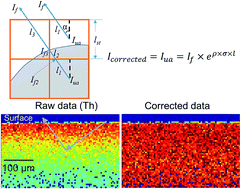A beam path-based method for attenuation correction of confocal micro-X-ray fluorescence imaging data†
Abstract
Confocal micro-X-ray fluorescence imaging (C-μXRF-I), an emerging X-ray spectroscopy technique for collecting X-ray fluorescence (XRF) data within intact objects, is beginning to see widespread use in many fields of study. However, the XRF intensity is attenuated during data collection, and corrections are required prior to data interpretation. A beam path (pixel)-based correction method is presented that takes into account heterogeneity of a sample and C-μXRF-I setup geometry. The sample heterogeneity is addressed by assuming the mass distribution of an element is the same as the XRF intensity distribution of the element in each pixel. The beam path in each pixel is calculated using the C-μXRF-I step size and geometry. The Beer–Lambert law is then applied to correct the attenuated XRF. The XRF intensity used to calculate the mass distribution is updated iteratively using values from the previous step, until the difference in intensity between the previous and current step is less than a threshold value. This correction method was verified using two distinct standard reference materials (NIST SRM 1834 and 611), and was then applied to imaging of fresh and aged switchgrass biochars. The corrected intensity of SRM 1834 indicates most elements were distributed homogeneously, but the distribution of some trace elements was more heterogeneous (P < 0.05). The corrected intensities of SRM 611 indicate all the elements are homogeneously distributed. The difference between the raw and corrected intensities for the biochar samples was not as pronounced as for standard reference materials due to a lower density and fewer high Z elements.



 Please wait while we load your content...
Please wait while we load your content...